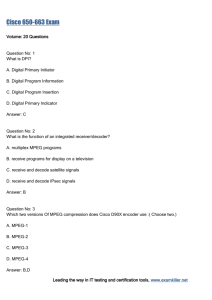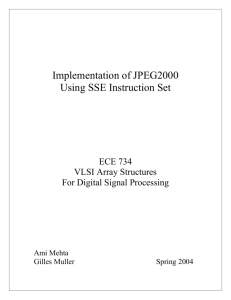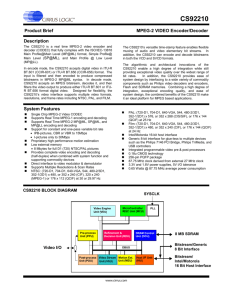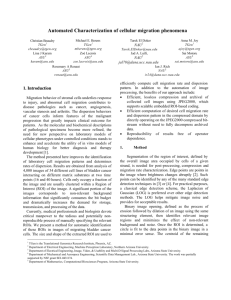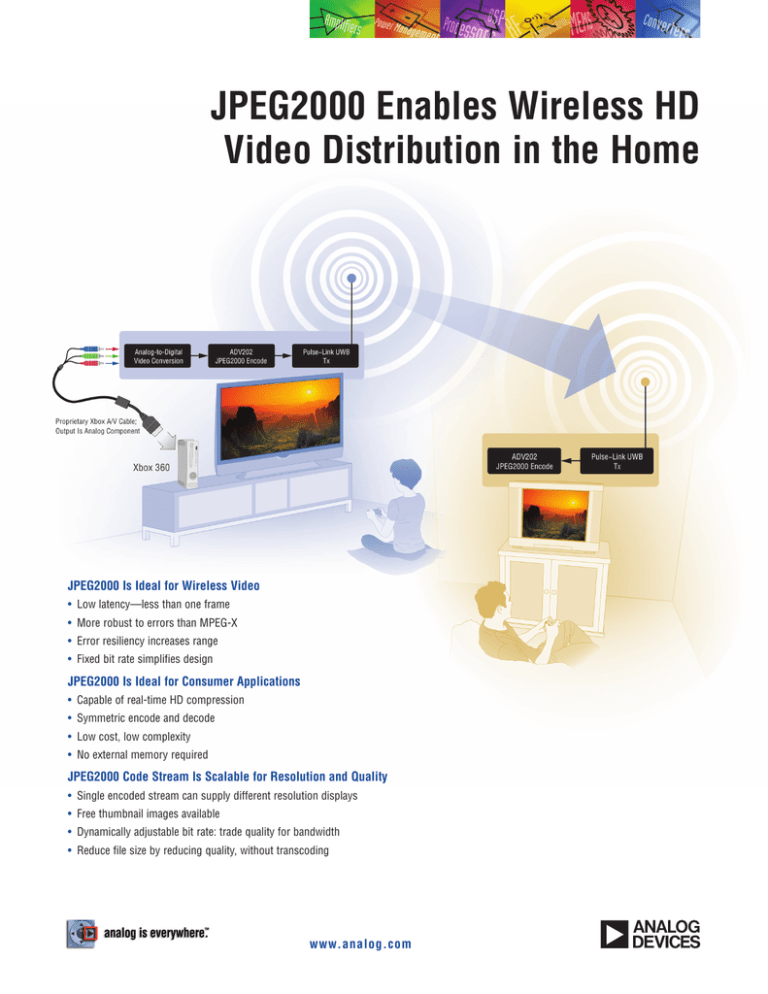
JPEG2000 Enables Wireless HD
Video Distribution in the Home
JPEG2000 Is Ideal for Wireless Video
• Low latency—less than one frame
• More robust to errors than MPEG-X
• Error resiliency increases range
• Fixed bit rate simplifies design
JPEG2000 Is Ideal for Consumer Applications
• Capable of real-time HD compression
• Symmetric encode and decode
• Low cost, low complexity
• No external memory required
JPEG2000 Code Stream Is Scalable for Resolution and Quality
• Single encoded stream can supply different resolution displays
• Free thumbnail images available
• Dynamically adjustable bit rate: trade quality for bandwidth
• Reduce file size by reducing quality, without transcoding
www.analog.com
Frequently Asked Questions
Q: Since most video reaches the home as MPEG-2, why not just
send it wirelessly?
Q: Doesn’t JPEG2000 consume a lot more bandwidth than
MPEG-2?
A: (Note that although MPEG-2 is used in this FAQ, the same
principles apply to answers for any temporal scheme.) Most
MPEG-2 video streams are already decoded before being sent
to the TV for various reasons: to add menu overlays, program
guides, etc. This is true for most set-top boxes, DVD players,
and digital broadcast receivers. The video is then either sent to
the TV in an uncompressed format or is recompressed using
an inexpensive encoder (for SD resolution).
A: Actual efficiency is different depending on whether the
transmission channel is error-free (wired) or noisy (wireless
or powerline). In a wired channel with no errors, JPEG2000
consumes about twice the bandwidth as MPEG-2 for SD and
HD video, at similar quality levels. For cable TV broadcast
or DVD compression, JPEG2000 is not competitive with
MPEG-2. However, as image resolution increases to 1080p
and beyond, MPEG-2 becomes less and less efficient. MPEG-2
encode complexity increases exponentially as the image size
increases, but JPEG2000 complexity is roughly linear. At some
point, JPEG2000 becomes more efficient, which is one reason
it was chosen by the Digital Cinema Initiative. It’s also worth
noting that JPEG2000 can perform lossless compression,
which may be attractive in high end wired and wireless HD
transmissions. For similar quality in an error-free transmission
environment, an SD MPEG-2 stream requires about 3 Mbps;
the equivalent JPEG2000 stream would be about 6 Mbps.
Similarly, 720p HD MPEG-2 stream requires about 16 Mbps;
the equivalent JPEG2000 stream of the same video would
consume about 30 Mbps.
Some video sources aren’t encoded in MPEG-2, or there is no
access to the MPEG-2 signal. Outputs from PCs and many DVD
players feature uncompressed analog or digital video formats,
such as DVI and HDMI. These will have to be compressed in
real time before being wirelessly transmitted from a PC or DVD
player to a display. The cost of a real-time HD MPEG-2 encoder
is roughly $20,000; clearly this is not a solution intended for
the consumer market.
JPEG2000 permits low cost, real-time compression of HD
video, enabling interactive applications and the transmission of
menu overlays.
Q: If I do have access to the MPEG-2 stream, why not send it
wirelessly?
In a wireless environment, JPEG2000 becomes much,
much more attractive. Because MPEG-2 manifests errors as
very obvious artifacts, much more forward error correction
(FEC) is required, and many more packets may have to
be retransmitted. FEC and retransmission both consume
bandwidth, requiring a large frame buffer with complex
memory and timing considerations. Once FEC is taken into
account, the bandwidth requirements of JPEG2000 may be less
than or equal to that of an MPEG-2 stream. Also, because the
decode is straightforward, the JPEG2000 solution will be less
expensive. Further, retransmission requires significant amounts
of buffer on the receiver, which can be costly and which
increases latency.
Using JPEG2000 has additional benefits that are discussed
below. Many of the benefits are related to the scalability of the
code stream, which, among other things, allows displays of
different resolutions to decode only the portions of the code
streams they need.
UWB provides ample bandwidth for JPEG2000, and allows the
other benefits of JPEG2000 to be realized.
A: The video community has identified two major problems with
video in wireless environments: error resiliency and latency.
Unless the application is interactive, latency is less of an issue
than error resiliency.
An error in an I-frame is visible through the entire group of
pictures (GOP), so a single transmission error can result in
several frames containing errors, creating disturbing artifacts.
JPEG2000 compresses each frame individually, so errors do
not propagate across frames. Also, JPEG2000 is a waveletbased scheme, and errors in the codestream tend to “soften”
the picture, not create blocky artifacts. Although JPEG2000 is
a digital compression scheme, it offers an analog-like graceful
degradation of image quality.
Q: Why not use MPEG-2 I-frame-only transmission? That way
errors wouldn’t propagate across multiple frames.
A: This requires real-time compression, and while real-time
MPEG-2 encoders do exist, real-time HD MPEG-2 encoders
are very expensive and complex. Like most compression
schemes, MPEG-2 was designed to be more complex on the
encode side than the decode; MPEG-2 simply wasn’t intended
for use in high volume encode applications.
Let’s suppose, though, that real-time HD I-frame-only
MPEG-2 encoding is feasible. I-frame-only MPEG-2 streams
are much higher bandwidth than typical streams and require substantially more resources to decode. Most MPEG-2 decoders
aren’t built to handle these bandwidths. New decoders would
have to be deployed, and they would be substantially more
complex and expensive than existing decoders.
Q: Why don’t we just wait for H.264? It’s going to address all of
these problems, right?
A: H.264 promises better compression efficiency, but there are
no advantages over MPEG-2 for wireless applications. Like
any motion estimation scheme, any errors will be propagated
throughout several frames.
Further, for recompression in the home (cases where the
stream didn’t originate in H.264) the encoder would require
too much space and cost too much for any consumer product.
Today, H.264 HD encoders are prohibitively expensive for
consumer electronics applications.
Q: Why not just make the wireless environment more robust?
A: Even in a robust environment errors will occur. Forward error
correction is a critical part of quality of service (QoS), but it
consumes bandwidth. Using less bandwidth on FEC means it
can be used elsewhere.
Q: What about security? Is there content protection for
JPEG2000?
A: The same questions apply to JPEG2000 as they do to MPEG-2
or H.264, or any other compressed video. It is very possible
to apply a content protection scheme, such as HDCP or
AES128, to a compressed stream. Since the input to all video
compression codecs is uncompressed video, the content
protection must be applied after compression, not before. At
the present time, many wireless chip vendors use AES128.
Recently, Sandia National Labs used 256-bit AES encryption to
secure real-time live-streaming video images over a wireless
UWB link for military applications.
Q: What is meant by “scalable” quality and resolution?
A: For quality, scalability means that the compressed code stream
is organized so that different quality levels can be extracted
without decompression. JPEG2000 will produce the best
possible image for the available bandwidth. If the channel is
50 Mbps, JPEG2000 produces the best possible image quality
for 50 Mbps. If the bandwidth drops to 25 Mbps, JPEG2000
will automatically produce the best possible image quality for
25 Mbps. Because it’s intraframe-only compression, the output
bit rate can be instantaneously adjusted to match channel
conditions.
Quality scalability also means that portions of the code stream
can be selectively protected. Like MPEG-2, the header of the
JPEG2000 code stream is the most important section and
errors to this section can be mitigated using FEC. Unlike
MPEG-2 though, some sections of the JPEG2000 stream are
more important than others and FEC can be applied only to
those sections. If the section of the packet containing very high detail is lost or damaged, the image will not suffer as
much as if the low frequency portion is disrupted. Because of
this, JPEG2000 makes more efficient use of FEC bandwidth
than does MPEG-2.
For resolution, scalability means that the compressed code
stream is organized so that different resolution levels (image
sizes) can be extracted without decompression. Any receiver
can decode just the portion of the code stream it requires,
allowing it to display its native resolution. The same JPEG2000
code stream could be broadcast to an HDTV, an SDTV, a
display in a remote control, or a PDA with ideal results. For
temporal schemes this is not possible; the highest resolution
must be decoded by each device before, which could be very
expensive for HD temporal decoders.
Some features of JPEG2000 may make it easier to apply
existing encryption methods. The fixed output bit rate of
JPEG2000 should make it easier to implement handshaking
and other timing-critical elements of content protection. The
intraframe-only compression may also ease system design
requirements.
Q: How do UWB and JPEG2000 enable wireless HD gaming?
Why can’t MPEG-2 be used?
A: The video from a gaming console must be compressed in real
time before being wirelessly transmitted. JPEG2000 provides
better image quality than MPEG-2 for real-time compression of
either SD or HD at the price points of interest.
Real-time compression is not the same thing as low latency.
Because it must wait for several compressed frames to
display a single decompressed frame, MPEG-2 has high
latency. Latency and bandwidth can be traded by going to
I-frame only, but, as discussed earlier, this is an expensive,
complex proposition even for SD; recall that real-time HD
MPEG-2 encoders are thousands of dollars.
The latency of a JPEG2000 stream is about one frame for
encode and one frame for decode. The total latency of the HD
game shown at CES 2006, using Analog Devices’ ADV202 and
Pulse~LINK’s CWave™ UWB technology, is less than 200 ms—
the user can’t tell that it’s a wireless video link.
Resolution Scalability
JPEG2000 COMPRESSION
Cell Phone
PDA
SDTV
HDTV
Analog Devices currently offers the ADV202, a JPEG2000-compliant codec. More information on
the ADV202 is available at: ftp.analog.com/pub/Digital_Imaging/ADV202_FTP_site_contents_3.html.
For more information, please contact: Brooke Crossley, High Speed Converters Marketing Manager
Phone: 336.605.4308
Email: brooke.crossley@analog.com
©2006 Analog Devices, Inc. All rights reserved.
Trademarks and registered trademarks are the property
of their respective owners.
Printed in the U.S.A.
PH05920-0-2/06
www.analog.com
Analog Devices, Inc.
Worldwide Headquarters
Analog Devices, Inc.
One Technology Way
P.O. Box 9106
Norwood, MA 02062-9106
U.S.A.
Tel: 781.329.4700
(800.262.5643,
U.S.A. only) Fax: 781.461.3113
Analog Devices, Inc.
Europe Headquarters
Analog Devices SA
17-19 rue Georges Besse
Antony, 92160
France
Tel: 33.1.46.74.45.00 Fax: 33.1.46.74.45.01
Analog Devices, Inc.
Japan Headquarters
Analog Devices, KK
New Pier Takeshiba
South Tower Building
1-16-1 Kaigan, Minato-ku,
Tokyo, 105-6891
Japan
Tel: 813.5402.8200
Fax: 813.5402.1064
Analog Devices, Inc.
Southeast Asia
Headquarters
Analog Devices
22/F One Corporate Avenue
222 Hu Bin Road Shanghai, 200021 China Tel: 86.21.5150.3000 Fax: 86.21.5150.3222

